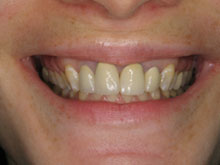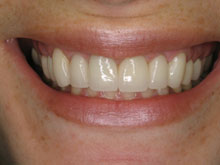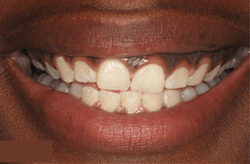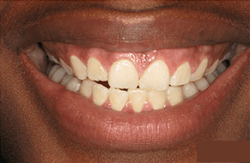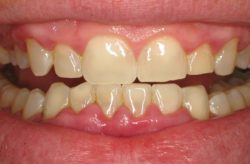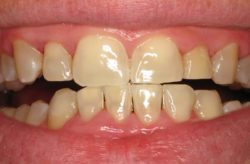Scaling And Root Planing as a Treatment for Gum Disease
Gum disease is a condition that affects numerous individuals worldwide. This condition is caused by the sticky plaque that collects and builds up on the surface of the teeth and, in severe cases, below the gum line.
In most instances, individuals are unaware they have gum disease due to the many forms. Gingivitis is the earliest stage of gum disease and, when left untreated, can progress to a much more severe stage known as advanced periodontitis.
Several procedures help treat this condition. Scaling and root planing are non-surgical procedures that involve removing plaque and calculus from the tooth’s base and pockets beneath the gum line and smoothing the affected tooth surface. These procedures are performed by periodontists using tools such as periodontal scalers and periodontal cutters.
What Is Scaling And Root Planing?
Periodontal scaling and root planing are the first steps in treating gum disease. This non-surgical procedure involves removing dental plaque and calculus, then smoothing the roots’ exposed surfaces. This procedure aims to eliminate the agents that cause inflammation, such as dentine or cementum.
Scaling involves the removal of the plaque and calculus deposits on the tooth surfaces, while root planing is smoothing the root surfaces to promote reattachment of the gum tissue to the tooth. This procedure is essentially a deep cleaning performed with handheld tools or ultrasonic devices.
Teeth scaling and root planing frequently require more than one dental visit and may require using a local anesthetic, depending on the severity of the gum disease. If gum recession is present, it may also increase how many dental visits are required.
When Is Scaling And Root Planing Necessary?
The gums are irritated and swollen for individuals who suffer from gum disease and frequently bleed. Typically, healthy gum tissue fits tightly around the tooth’s surface. When bacteria and plaque accumulate underneath the gumline, the tissue begins to pull away from the tooth’s surface, forming pockets.
Gum pockets should measure about 1 to 3 millimeters in depth. Once the pockets measure four millimeters or more, scaling and root planing are recommended to remove plaque buildup. If severe periodontitis is left untreated, it can cause bone loss, loose teeth, and tooth sensitivity. If you notice signs of gum disease, we recommend immediate consulting with one of our experienced specialists.
What To Expect During Scaling
During the scaling procedure, our specialists will utilize a handheld tool known as a dental scaler to remove plaque on the surface of the teeth and below the gumline. Plaque and tartar, yellow or brown hardened plaque, are then scraped off the tooth’s crown and roots. We may apply a local or topical anesthetic if necessary to prevent discomfort.
What to Expect During Root Planing
Once the plaque and tartar have been removed from the pockets and have been sterilized, the root planing procedure begins. A root planing tool is used to smooth out any rough surfaces on the tooth’s root. This provides a healthy surface for the gums to reattach properly, so bacteria and food particles do not get trapped below the gumline. A local anesthetic is administered during this procedure to minimize any discomfort or pain that may be felt during.
After Treatment Care
As with many dental procedures, some symptoms may be felt following the scaling and root planing procedure. Common symptoms include:
- Tooth Sensitivity. New sensitivity to temperature changes and sweet or cold drinks may be felt after the scaling and root planing. The sensitivity is minor and typically lasts two to three days after treatment.
- Pain and Discomfort. Discomfort may be experienced during and following the procedure. This is normal since the hygienist works subgingival, below the gum line, during the procedure. Due to the slight discomfort, a local anesthetic is used to numb the area. It is advised to avoid chewing hard foods until the numbness wears off.
- Bleeding. It is normal to experience slight bleeding while brushing or flossing after scaling and root planing. The bleeding typically stops three days after the treatment.
Practicing proper oral care at home is essential in preventing gum disease. Therefore, make sure to brush your teeth twice a day and floss daily to maintain a healthy mouth. Our specialists may prescribe medication to a specific mouthwash to prevent infection and regulate the pain and discomfort felt after the treatment.
In addition to regular brushing and flossing, be sure to schedule regular visits with our specialists every six months for dental tooth cleanings and oral health examinations. Dental visits can help resolve potential issues and keep your dental health on track.
FAQ
What are scaling and root planing?
Periodontal scaling and root planing is a procedure that removes bacteria and plaque from the gum line to treat periodontal disease. This procedure is essentially a deep cleaning performed with handheld tools or ultrasonic devices. This procedure aims to eliminate the agents that cause inflammation, such as dentine or cementum.
How to do scaling and root planing?
This procedure involves removing bacteria or calculus from the teeth and beneath the gum line. The process entails a dental professional using a handheld scraper or an ultrasonic device to loosen and remove plaque and smoothen the root’s surface to prevent any re-emergence of bacteria.
Do scaling and root planing hurt?
Scaling and root planing does not hurt. Our specialists will administer a local or topical anesthetic during the procedure to numb the gums and lessen discomfort. However, you may feel slight pain following the procedure, but the discomfort usually dissipates after a few days. Typically, scaling and root planing risks are minimal, so you don’t have to worry about significant side effects.
Is scaling and root planing the same as deep cleaning?
Yes. Dental root planing and scaling is another term for deep cleaning. Scaling is the removal of plaque and tartar from the teeth and gum pockets, whereas root planing is the removal of plaque and calculus from the surface of the tooth’s root. Periodontal scaling and root planing before and after are like night and day. You will notice an immediate difference.
Are periodontal scaling and root planing necessary?
Chronic periodontitis, also known as gum disease, can cause bone and connective tissue damage, which requires bone or tissue grafting. Gum disease is the leading cause of tooth loss in adults. As a result, gum scaling and root planing are necessary treatments when symptoms of gum disease are present.
How long do gums take to heal after scaling and root planing?
Following tooth root planing and scaling, you may experience minor discomfort around the teeth for several days and increased sensitivity to hot, cold, and spicy foods or hot and cold beverages for up to four to six weeks. This is a usual phase in the healing process.
Is scaling and root planing painful?
Root planing and scaling treatment can make your mouth sore. However, the procedure itself is not painful. Our specialist will apply a local anesthetic; therefore, you should not feel any pain during the procedure.

